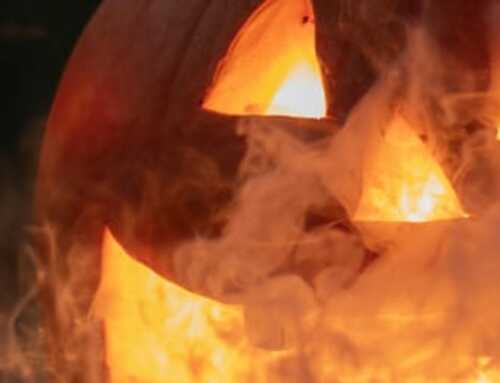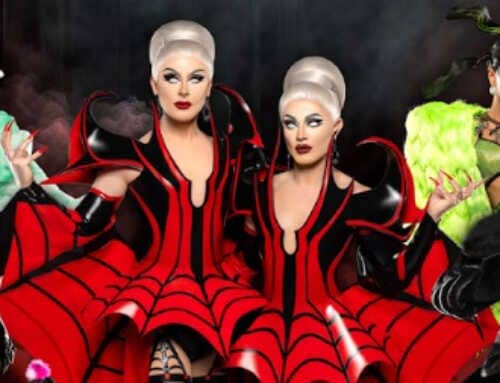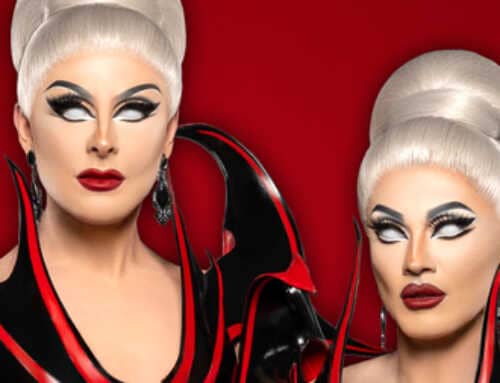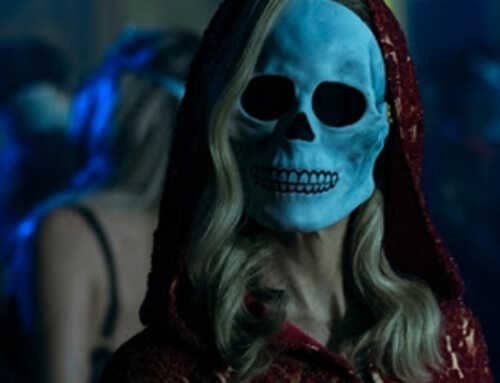The Shivering Truth premiered on Cartoon Network’s Adult Swim in May of 2018. The quarter-hour episodic is a surreal fever dream of existential dread told with stop-motion animation in a sort of wandering, stream of consciousness format that addresses everything from demons to the physical universe literally oozing out of a character’s head. This is cerebral absurdity that somehow captures the unfilmable concepts and silly ideations of a painfully creative pair, writer Vernon Chatman and writer-director Cat Solen.

With season two of The Shivering Truth premiering May 10th, on Adult Swim, we had the chance to speak with Solen about the show. How did something so surreal make it to the screen? What is the process of creating an animated series that explores such heady concepts in a comedic way? We get to all of that here.
Enjoy.
HorrorBuzz: When is it that you see the script? Are you at all involved in the development of the story or the topic you guys are covering?
Cat Solen: Vernon and I have a history together that has kind of all been developmental. We first met through mutual friends who had told us both ahead of time, like, you two need to work together. So we kind of knew right away when we met there was like a kindred spirit there. And we both kind of had that the same thing at the same time. We knew instantly, like, oh, we’re gonna do a project someday. That was seven years before we made the pilot. So for years, he and I, when we were in the same city would get together and just kind of have conversations that were Vernon’s kind of stream of consciousness-like the episodes are. But they were about general concepts and ideas, art, films, and music we love and we kept sharing.
We have countless sharing screens of Image references in just art and, and book recommendations and movie recommendations. He and I are voracious consumers of content that is especially hard to find and outdated. That’s kind of where the show started was we knew tonally kind of personality-wise.
And Vernon, I just love writing with him so much. What I love about working with Vernon is that he is capable of imagining things that are impossible to put on the screen and I have to work. I have to work with them to figure it out. When I say impossible, I mean, like, physically, like, if it makes sense if you read something and emotionally you understand it, and emotionally it makes sense. But don’t tell anybody how to feel it, you know? And that’s what’s beautiful about writing and poetry. That’s also what I love about filmmaking; trying to show something that is like that is impossible to picture, but that you know how it feels already.
So what he (Vernon) does is he, he writes beautiful poetic things all the time, that takes a lot of time for him. Once the script is done, then I sit down with him and we talk about it for hours. We talk about every single, tiny moment in the script, and physically how it’s possible. We go through tons of scenarios and me, I draw a lot to explain myself and so, I will sit there and draw thumbnails of everything he is saying to me as a way of “saying” it back to him. I just like dive deeper and deeper and deeper into every little tiny pocket.
So on all of the episodes, I will sit with him while he would be talking rapidly. Then we do our board art and then I take our board art and we dive into it from there, and then the border, more, more detailed version of that thumbnail and try to work out. Like there’s only so much you can do if you’re given a period of time. It always helps another step in the animatics process to figure out basically how it physically exists.
It’s not the kind of show that would ever have everything laid out. It’s the kind of show you have to figure it out with.
HB: So as far as directing, you are there from the second ideas get thrown around. You’re in development along with the Vernon. You’re directing it as you’re going.
CS: So Vernon, because he’s so busy with his writing, he can’t be at the studio every day. I’m there, designing things, building physically building things, directing all of the animation and directing all of the fabrication. all of the production design, all the art-making animatics. He and I talk nearly every single moment throughout. He’s often not there for the actual production. He’s there more in the beginning and in the post. Oftentimes I’ll call him up and he and I will figure things out right there in the moment. But we have to be really, really, on top of every single detail up until that point to have time to even tackle those things. If we don’t conceptualize everything heavily up until that point, it would be such a mess. But then we wouldn’t be able to ever solve these other more nuanced things that come up just like on the day with an animator.

HB: The show is entirely too intricate and complicated to just say, oh, we’ll figure it out.
CS: Exactly. Yeah. I’m really excited about it. I love animatics. I love doing things exactly as they are. Our animatics are super detailed. Our board art that we have throughout production, we have software that we use track elements. And in that software, every single prop has its own folder with reference on how it’s supposed to look. So it’s, it’s really, it’s really specific.
I think, not the bad way. It’s a very challenging show to make. That’s what I love about it.
HB: How long does it take like, once you have a script in hand, how long does it take to create a finished episode?
CS: The pilot took about four and a half months, all in for the pilot. But while we had more time on the pilot, we had less infrastructure, we needed more time for development. Nowadays, this season, I think we’ve gotten it down to maybe three months per episode, but they’re all their schedules. So they all kind of overlap each other. As we go. So total. This production was probably About 10 months for season two, season one was about eight months.
HB: What are what are some? What are some of the key elements for any episode of the show?
CS: Vocal talent is a really important part. Vernon and I spend a lot of time talking about who should play what roles and how we are going to connect with people that we already kind of know through friends or through people that we’ve worked within the past.
Vernon’s voice over to all the sound design is like, very, very specific, and very crucial. And it’s so important and it’s why I love it so much. I love the way the show sounds in every single aspect. People say that sound is 50% of your film. And I was thinking with The Shivering Truth it’s even a little more than 50% because it is the number one thing that is there in each episode. It’s the thing that’s in every single episode where every almost everything else visually can change. So I think that that’s a very crucial thing.
A lot of the people that are in the show or are, you know, people Vernon and I both loved and worked or known or just really psyched that we actually got the chance to finally work with. That’s really important to me.
HB: Sorry. I’m just like, flashing on the peekaboo prodigy. You take the jokes so far. You go so far with that. That’s one of the that’s, that’s one of the key elements of The Shimmering Truth is that you don’t just do a joke, you dive deeper.
CS: That’s all Vernon. He actually has really inspired me to think more that way and working with him. He, he always, like, “Okay, what can we do? How can we push even more? Where can we go now? And what does that mean? And what is that? Like, how does that inform what we’re telling? It’s a really serious process. Every single moment, we try to find something else to add to that moment, that the overall moment and also take it into a deeper, more like “AAAAAA!” kind of place.
HB: You guys go to some dark places in the season 2 premiere. I mean, there’s even 911 joke, you know? I’m like, “Okay, this is hilarious, but what is it that makes something like that work?”
CS: I think it’s coming to it with sincerity. Like it’s not, it’s not trying to be sentimental, it’s trying to be sincere. If you’re telling a really dark joke, you’re telling us our joke about something that is really was really intense. If you’re going to do it, I think you have to do it with feeling. You can’t ever be ironic with it or make a joke of it. You have to, you’re telling a joke already. And you have to tell it sincerely.
I found, even when I whenever I’m trying to tell the saddest story that’s still always humor in it. It’s kind of the reverse version of that. It’s like, it’s like you’re trying to say something really funny and there’s still always sadness in it. So it’s kind of working with those It’s also a commentary on how we let bad or hard things kind of inform us in our lives and what that means.
That episode is one of our most divisive episodes I think. And I really I’m really proud of it. I really liked that episode. I really love the lead character in that episode, Hank, he’s really special to me. I think he’s so sweet and kind and just trying to do the right thing. I’m reliving it a little bit as we are talking, you know? It’s the fever dream making it. Just the other day Vernon and I were like “You remember anything that we did?” And we both were like, “What did we do?”
HB: t feels like it feels like a weird They Might Be Giants song. Who do we have to thank for hurting you and Vernon?
CS: (laughter) A mutual friend named Daniel. He knows, he just knows who should work together. He’s awesome. Yeah. I met Daniel at a random meeting that my agent sent me to and we became friends.
HB: Cool. we’ll look him up and send a “thank you” card.
CS: I would say overall this season ups the ante. It’s insane, this season. There we things we did this season that last season would have felt completely impossible to do. I think if we hadn’t done last season we would not have been able to do this season in that we learned that we brought with us. I mean impossible in a conceptual standpoint or a technical standpoint or like, oh, maybe we shouldn’t touch this subject or in all of those ways, yeah. In all three of those, like, all of those ways, conceptually, like, how do we actually make this idea? People?
Also, like subject matter wise, like there are certain things in some of the episodes that Vernon and I were like, “Are we really gonna do this? Okay.” We really pushed, we really, really pushed this season to write to a bigger scope. It’s much, much bigger. And it’s, it’s crazy. There are way more sets there’s way more puppets, more characters, more scenarios. Last season, we had, I think, one demon the whole season that had a very very short moment. This season we have four different demons at least, and they all had speaking roles and full bodies that needed to each has their own character design. I love those demons. They’re really amazing. It was really fun to design all of those guys.
HB: Do us a favor. Please don’t let the look get too polished.
CS: I don’t know that could be possible. Part of the thing about it is that makes it what it is, is that no matter how good we can make it, look there’s always going to be the challenge of material that it is bigger in scope than anything you could ever make. Purposely Yeah, it’s always gonna have that look like that, no matter what we do.







